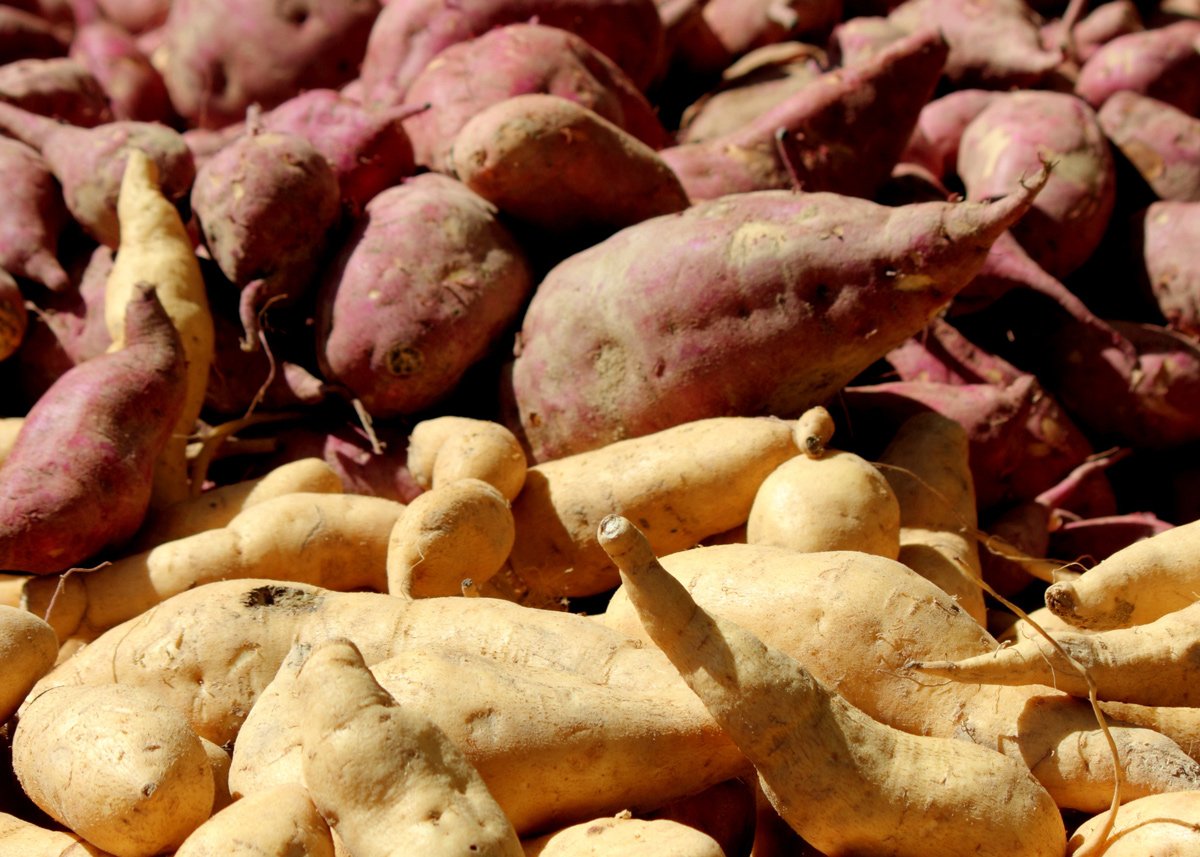Yams, Yapoks & Yellow – A Look at South America

 I Yam What I Yam … Or Not? Disentangling the sweet potato and the yam.
I Yam What I Yam … Or Not? Disentangling the sweet potato and the yam.
Yam is the common name for some plant species in the genus Dioscorea that form edible tubers. Yams are perennial herbaceous vines cultivated for the consumption of their starchy tubers in many temperate and tropical regions, especially in Latin America, Africa, Asia, and Oceania.
Let’s clear up one very important point: Sweet potatoes are not a type of yam, and yams are not a type of sweet potato. They are both tuberous root vegetables that come from a flowering plant, but they are not related and actually don’t even have a lot in common.
Yams are native to Africa and Asia, with the majority of the crop coming from Africa. They are related to lilies, and can be as small as a regular potato or jumbo in size (some grow five feet long!). Yams have a cylindrical shape with blackish or brown, bark-like skin and white, purple, or reddish flesh.
Compared to sweet potatoes, yams are starchier and drier. They’re carried in more grocery stores these days, but your best chance of finding them is to look in international and specialty markets.
Yapok
 Yapok is another name for the species Chironectes minimus, also known as the water opossum. Yapoks are smaller than their counterparts, with an average length of about 14 inches. They are very interesting creatures, they are the only aquatic maruspial. As a result, their pouch is actually waterproof. This means the mother yapok can swim around with her babies in her pouch, and they are protected while they are still developing. This, along with their webbed hind feet makes yapoks very well adapted to spend much of their time in the water.
Yapok is another name for the species Chironectes minimus, also known as the water opossum. Yapoks are smaller than their counterparts, with an average length of about 14 inches. They are very interesting creatures, they are the only aquatic maruspial. As a result, their pouch is actually waterproof. This means the mother yapok can swim around with her babies in her pouch, and they are protected while they are still developing. This, along with their webbed hind feet makes yapoks very well adapted to spend much of their time in the water.
Habitat
Yapoks can be found throughout Central and South America, from Mexico all the way down to Argentina. As the name ‘water opossum’ implies, they prefer to live in wet areas in warm climates. They build their nests along the banks of freshwater rivers and lakes, and they typically live in or near tropical and sub-tropical forests.
Yapoks build their nests underground. They dig steep tunnels that end in a nest or den area, which is like a small, dug-out cave. This is where they sleep, hide from predators, and raise their young.
Yapoks are marsupials, meaning they give birth to live young and raise them in a pouch on their stomachs. Water opossums are very solitary. The only time they interact with other members of their species (aside from chasing them away) is during mating season and when a mother raises her young.
 Parenting
Parenting
Male yapoks will often protect the female until the babies are born, but he does not help raise them. The babies stay in the mother’s pouch until they are about two months old. After that, they are developed enough to leave the pouch and will spend a while longer with the mother, travelling around on her back. There can be anywhere from one to five babies in a litter, or nest.
Foraging
Since they spend their lives near the water, it makes sense that the yapok’s food comes from the water as well. They eat a variety of aquatic, or water-based, animals, including fish, frogs, water insects and larvae, and crabs and other crustaceans. They forage underwater by closing their eyes and ears and feeling around. Their sensitive whiskers and fingers held them find and grab their pray.
Yellow
Let’s take a look at the meaning of the colour yellow around the World including South America…
 Western cultures (North America and Europe) The bright cheery nature of yellow is the predominant meaning in most Western nations. It is associated with warmth (the sun), summer and hospitality. In the United States, specifically, the colour is associated with transportation — taxis and school buses are yellow as are many different types of street signage. Tea maker Lipton, for example, uses yellow to market worldwide. In Germany, yellow is associated with envy (which is described as green in most other Western cultures).
Western cultures (North America and Europe) The bright cheery nature of yellow is the predominant meaning in most Western nations. It is associated with warmth (the sun), summer and hospitality. In the United States, specifically, the colour is associated with transportation — taxis and school buses are yellow as are many different types of street signage. Tea maker Lipton, for example, uses yellow to market worldwide. In Germany, yellow is associated with envy (which is described as green in most other Western cultures).
Eastern and Asian cultures Members of the royal ruling class often wear this hue and the colour is considered sacred and imperial. In Japan, that definition is expanded to include courage (which is expected of rulers) and is the colour of commerce in India.
 Latin America On the contrary, yellow is associated with death and mourning in many Latin cultures.
Latin America On the contrary, yellow is associated with death and mourning in many Latin cultures.
Middle East Though in Egypt, yellow is most closely associated with mourning (in much the same way as Latin American nations), it is more widely connected to happiness and prosperity in the Middle East. The associations with yellow are closely related to those of Western cultures.
Around the world In many African nations, only people with high rank in society can wear yellow. The more gold variations of the colour are universally associated with money, quality and success in most world cultures.

